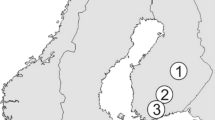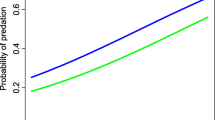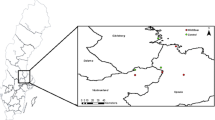Abstract
As urbanization increases, the identification of nest predators becomes important for avian conservation and management of urban wildlife communities. We investigated bird nest predation using artificial nests in urban areas of the KwaZulu-Natal (KZN) Province of South Africa. From June 2013 through February 2014 we installed seventy-five artificial nests in 25 suburban gardens in the Ethekwini and Msunduzi municipalities of KZN. Euplectes spp. nests were used and baited with two quail-sized, hand-made, silicon eggs. These were placed in residential gardens and monitored by camera traps for 2-weeks in winter, spring and summer respectively. Generally bird nesting occurs throughout the year in KZN’s subtropical climate, with some avoidance during the autumn season. Therefore, experiments were not conducted during autumn, as fresh nests were not available for use. Overall the rate of predation on artificial nests was 25 % (n = 19), with vervet monkeys Ceropithecus aethiops pygerythrus predating 20 % (n = 17) of the nests while domestic cats Felis catus predated 3 % (n = 2) of nests. Nest predation was significantly higher in the winter season, with 79 % of depredations occurring in winter (n = 15), 16 % in spring (n = 3) and 5 % in summer (n = 1), and in areas with less canopy cover. Our results suggest that vervet monkeys may have a negative impact on nesting birds in urban environments, however, in order to assess the rate of predation experiments on natural nests coupled with information on fledgling success is deemed necessary to investigate avian population declines.



Similar content being viewed by others
References
Alexandrino ER, Luz DTA, Maggiorini EV, Ferraz KMPMB (2012) Nest stolen: the first observation of nest predation by an invasive exotic marmoset (Callithrix pernicillata) in an agricultural mosaic. Biota Neotrop 12:211–215
Bartoń K. MuMIn: multi-model inference. R package version 1.9.5. 2013.
Baudains TP, Lloyd P (2007) Habituation and habitat changes can moderate the impacts of human disturbance on shorebird breeding performance. Anim Conserv 10:400–407
Beckerman AP, Boots M, Gaston KJ (2007) Urban bird declines and the fear of cats. Anim Conserv 10:320–325
Bicca-Marques JC, Calegaro-Marques C (1994a) Exotic plant species can serve as staple food sources for wild howler populations. Folia Primatol 63:209–211
Bicca-Marques JC, Calegaro-Marques C (1994b) Feeding behavior of the black howler monkey (Alouatta caraya) in a seminatural forest. Acta Biologica 16:69–84
Bicca-Marques JC, Muhle CB, Prates HM, Oliveira SG, Calegaro-Marques C (2009) Habitat impoverishment and egg predation by Alouatta caraya. Int. J. Primatol. 30:743–748
Bicca-Marques JC, Silveira I, Martins LD (2014) Artificial nest predation by brown howler monkeys (alouatta guariba clamitans). Eur J Wildl Res 60:109–112
Blancher P (2013) Estimated number of birds killed by house cats (Felis catus) in Canada. Avian Conserv Ecol 8:3
Bonnington C, Gaston KJ, Evans KL (2013) Fearing the feline: domestic cats reduce avian fecundity through trait-mediated indirect effects that increase nest predation by other species. J Appl Ecol 50:15–24
Borgmann KL, Rodewald AD (2004) Nest predation in an urbanizing landscape: the role of exotic shrubs. Ecol Appl 14:1757–1765
Burnham KP, Anderson DR (2002) Model selection and multimodel inference: a practical information-theoretical approach, 2d edn. Springer-Verlag, New York
Calcagno V, de Mazancourt C (2010) Glmulti: an R package for easy automated model selection with (generalized) linear models. J Stat Softw 34:1–29
Carter SP, Bright PW (2002) Habitat refuges as alternatives to predator control for conservation of endangered Mauritian birds. In: Veitch CR, Clout MN (eds) Turning the tide: the eradication of invasive species. IUCN, Gland, Switzerland, pp. 71–78
Clark ME, Martin TE (2007) Modelling tradeoffs in avian life history traits and consequences for population growth. Ecol Model 209:110–120
Cowlishaw G, Dunbar R (2000) Habitat disturbance. In: Cowlishaw G, Dunbar R (eds) Primate conservation biology. The University of Chicago Press, Chicago, pp. 191–241
Cronje P (2013) Raider of the baglafecht weaver nest: vervet monkey. Ornith Observ 4:131–132
Dart R (1963) The carnivorous propensity of baboons. Symp Zool Soc Lond 10:49–56
Davison WB, Bollinger EK (2000) Predation rates on real and artificial nests of grassland birds. Auk 117:147–153
de Almeida MV, da Silva LA, da Costa TVV, de Paula HMG (2013) Predation on artificial nests by marmosets of the genus Callithrix (primates, platyrrhini) in a cerrado fragment in southeastern Brazil. Biotemas 26:203–207
DeGraaf RM, Maier TJ (1996) Effect of egg size on predation by white-footed mice. Wilson Bull 108:535–539
Development Core Team R (2014) R: a language and environment for statistical computing. R Found Stat Comp, Vienna, Austria Retrieved from http://www.R-project.org
Dickman CR (2009) House cats as predators in the Australian environment: impacts and management. Hum Wildl Conf 3:41–48
Evans KL (2004) The potential for interactions between predation and habitat change to cause population declines of farmland birds. Ibis 146:1–13
Fairbanks LA, McGuire MT (1984) Determinants of fecundity and reproductive success in captive vervet monkeys. Am J Primatol 7:27–38
Fedigan L, Fedigan LM (1988) Cercopithecus aethiops: a review of field studies. In: A G-H, F B, JP G, J K (eds) In: A primate radiation: evolutionary biology of the African guenons. Cambridge University Press, Cambridge, pp 389–411
Feild JG, Henke SE, McCoy JG (1997) Depredation on artificial ground nests by Japanese macaques: the unspoken exotic in Texas. Great Plains Wildl Damage Control Work Proc. Paper 367
Ferguson JWH (1994) Do nest site characteristics affect the breeding success of red bishops Euplectes orix? Ostrich 65:274–280
Ferreira RG, Resende BD, Mannu M, Ottoni EB, Izar P (2002) Bird predation and prey-transfer in brown capuchin monkeys (Cebus apella). Neotrop Prim 10:84–89
Fischer JD, Cleeton SH, Lyons TP, Miller JR (2012) Urbanization and the predation paradox: the role of trophic dynamics in structuring vertebrate communities. Bioscience 62:809–818
Fox J, Weisberg S, Friendly M, Hong J (2014) Effects: effect displays for linear, generalized linear, multinomial-logit, proportional-odds logit models and mixed-effects models. R Package version 3.0–0
Friedl TW, Klump GM (2000) Nest and mate choice in the red bishop (Euplectes orix): female settlement rules. Behav Ecol 11:378–386
George T (1987) Greater land bird densities on island vs. mainland: relation to nest predation level. Ecology 68:1393–1400
Gering JC, Blair RB (1999) Predation on artificial bird nests along an urban gradient: predatory risk or relaxation in urban environments? Ecography 22:532–541
Goodman SM (1989) Predation by the grey leaf monkey (Presbytis hosei) on the contents of a bird’s nest at Mt. Kinabalu park, Sabah. Primates 30:127–128
Hassan A (2001) Notes on olive baboons at lake Manyara national park. Ecol J 3:192–195
Hausfater G (1976) Predatory behavior of yellow baboons. Behaviour 56:44–68
Hoffman TS, O’Riain MJ (2012) Monkey management: using spatial ecology to understand the extent and severity of human–baboon conflict in the cape peninsula, South Africa. Ecol Soc 17:13
Horak D, Ondřej S, Tószögyová A, Albrecht T, Ferenc M, Jelínek V, Storch D (2011) Geographic variation in avian clutch size and nest predation risk along a productivity gradient in South Africa. Ostrich 82:175–183
Jokimaki J, Huhta E (2000) Artificial nest predation and abundance of birds along an urban gradient. Condor 102:838–847
Kumara HN, Singh ME, Sharma AK, Singh MR, Kumar MA (2000) Faunal component in the diet of lion-tailed macaque. Primate Rep 58:57–65
Loss SR, Will T, Marra PP (2013) The impact of free-ranging domestic cats on wildlife of the United States. Nat Commun 4:1396
Major RE, Kendal CE (1996) The contribution of artificial nest experiments to understanding avian reproductive success: a review of methods and conclusions. Ibis 138:298–307
Marini MA, Melo C (1998) Predators of quail eggs, and the evidence of the remains: implications for nest predation studies. Condor 100:395–399
Marzluff JM (2001) Worldwide increase in urbanization and its effects on birds. In: Marzluff JM, Bowman R, Donnelly R (eds) Avian ecology and conservation in an urbanizing world. Kluwer Academic, Norwell, MA, pp. 19–47
Maxson SJ, Oring LW (1978) Mice as a source of egg loss among ground-nesting birds. Auk 6:582–584
McKinney ML (2002) Urbanisation, biodiversity, and conservation. Biol Sci 52:883–890
McKinney T (2011) The effects of provisioning and crop-raiding on the diet and foraging activities of human-commensal white-faced capuchins (Cebus capucinus). Am J Primatol 73:439–448
Melampy MN, Kershner EL, Jones MA (1999) Nest predation in suburban and rural woodlots of northern Ohio. Am. Midl. Nat. 141:284–292
Michalski F, Norris D (2014) Artificial nest predation rates vary depending on visibility in the eastern Brazilian amazon. Acta Amazon. 44:393–396
Molsher R, Newsome A, Dickman C (1999) Feeding ecology and population dynamics of the feral cat (Felis catus) in relation to the availability of prey in central-eastern New South Wales. Wildl Res 26:593–607
Newmark WD, Stanley TR (2011) Habitat fragmentation reduces nest survival in an Afrotropical bird community in a biodiversity hotspot. Proc Natl Acad Sci 108:11488–11493
Nogales MA, Martin BR, Tershy CJ, Donlan D, Veitch N, Puerta B, Alonso J (2004) A review of feral cat eradication on islands. Conserv Biol 18:310–319
Nour N, Matthysen E, Dhondt AA (1993) Artificial nest predation and habitat fragmentation: different trends in bird and mammal predators. Ecography 16:111–116
Olmos F (1990) Nest predation of plumbeous ibis by capuchin monkeys and greater black hawk. Wilson Bull 102:169–170
Oschadleus HD, Underhill LG (2006) Breeding seasonality and primary moult parameters of Euplectes species in South Africa. Ostrich 7:142–152
Pasternak GM, Brown LR, Kienzie S, Fuller A, Barrett L, Henzi SP (2013) Population ecology of vervet monkeys in a high latitude, semi-arid riparian woodland. Koedoe 55:1–9
Pryke SR, Lawes MJ (2004) Female nest dispersion and breeding biology of polygynous red-collared widowbirds (Euplectes ardens). Auk 121:1226–1237
Reidy JL, Stake MM, Thompson FR (2008) Golden-cheeked warbler nest mortality and predators in urban and rural landscapes. Condor 110:458–466
Reidy JL, Thompson FR III. (2012) Predator identity can explain nest predation patterns. In: Ribic CA, Thompson III FR, Pietz PJ (eds) Video surveillance of nesting birds. Studies in avian biology, vol 43. Cooper Ornithological Society, Camarillo, pp 135–148
Richardson TW, Gardali T, Jenkins SH (2009) Review and meta-analysis of camera effects on avian nest success. J Wildl Manag 73:287–293
Ricklefs RE (1969) An analysis of nesting mortality in birds. Smithson Contrib Zool 9:1–48
Roberts DC, Diederichs N (2002) Durban’s local agenda 21 programme: tackling sustainable development in a post-apartheid city. Environ Urban 14:189–201
Robinson SK (1985) Coloniality in the yellow-rumped cacique as a defense against nest predators. Auk 102:506–519
Robinson WD, Robinson TR (2001) Observations of predation events at bird nests in central panama. J Field Ornithol 72:43–48
Robinson WD, Rompre G, Robinson TR (2005) Videography of panama bird nests shows snakes are principal predators. Ornito Neotrop 16:187–195
Rodewald AD, Kearns LJ, Shustack DP (2011) Anthropogenic resource subsidies decouple predator-prey relationships. Ecol Appl 21:936–943
Saj TL, Sicotte P, Patterson JD (2001) The conflict between vervet monkeys and farmers at the forest edge in Entebbe, Uganda. Afr J Ecol 39:195–199
Schmidt KA, Whelan CJ (1999) Nest predation on woodland songbirds: when is nest predation density dependent? Oikos 87:65–74
Schwarzkopf L, Rylands AB (1989) Primate species richness in relation to habitat structure in Amazonian rainforest fragments. Biol. Conserv. 48:1–12
Schwitzer C, Glatt L, Nekaris KA, Ganzhorn JU (2011) Responses of animals to habitat alteration: an overview focusing on primates. Endanger Species Res 14:31–38
Shaffer TL (2004) A unified approach to analyzing nest success. Auk 121:526–540
Shochat E, Warren PS, Faeth SH, McIntyre NE, Hope D (2006) From patterns to emerging processes in mechanistic urban ecology. Trends Ecol Evol 21:186–191
Sieving KE (1992) Nest predation and differential insular extinction among selected forest birds of central panama. Ecology 73:2310–2328
Skinner JD, Chimimba CT (2005) The mammals of the southern African subregion, 3rd edn. Cambridge University Press, Cambridge
Skinner JD, Skinner CP (1974) Predation on the cattle egret Bubulcus ibis and masked weaver Ploceus velatus by the vervet monkey Cercopithecus aethiops. S Afr J Sci 70:157–158
Sorace A, Gustin M (2009) Distribution of generalist and specialist predators along urban gradients. Landsc Urban Plan 90:111–118
Spanhove T, Lehouck V, Boets P, Lens L (2009) Forest fragmentation relaxes natural nest predation in an Afromontane forest. Anim Conserv 12:267–275
Sperry JH, Peak RG, Cimprich DA, Weatherhead PJ (2008) Snake activity affects seasonal variation in nest predation risk for birds. J Avian Biol 39:379–383
Statistics South Africa (2007) Community Survey. Retrieved from http://www.statssa.gov.za/publications/P0301/P0301.pdf
Stearns M, White BC, Schneider E, Bean E (1988) Bird predation by captive woolly monkeys (Lagothrix lagotricha). Primates 29:361–367
Steyn L (2014) Comparative determination of the numbers of four garden bird species, the house sparrow, Passer domesticus, the cape glossy starling, Lamprotornis nitens, the cape turtle dove, Streptopelia capicola and the laughing dove, Streptopelia senegalensis in the Johannesburg and vaalwater areas with study into possible causes of expected declines. MSc thesis, University of Johannesburg
Stracey CM (2011) Resolving the urban nest predator paradox: the role of alternative foods for nest predators. Biol Conserv 144:1545–1552
Stracey CM, Robinson SK (2012) Does nest predation shape urban bird communities? In Lepczyk CA, Warren PS (eds) Urban bird ecology and conservation. Studies in Avian Biology (no. 45). University of California Press, Berkeley, CA, pp. 49–70
Tarboton WR (2011) Roberts guide to the nests and eggs of southern African birds. Jacana Media, Cape Town
Tarwater C (2008) Predators at nests of the western slaty antshrike (Thamnophilus atrinucha). Wilson J Ornithol 120:620–624
Thorington KK, Bowman R (2003) Predation rates on artificial nests increase with human housing density in suburban habitats. Ecography 26:188–196
Tokuyama N, Furuichi T (2014) Redirected aggression reduces the cost for victims in semi-provisioned free-ranging Japanese macaques (Macaca fuscata fuscata). Behaviour 151:1121–1141
Urbanek S (2010) Low-Level R to Java Interface. R package version 0.8–8, URLhttp://CRAN.R-project.org/package=rJava.
Vander Haegen WM, Schroeder MA, De Graaf RM (2002) Predation on real and artificial nests in shrub steppe landscape fragmented by agriculture. Condor 104:496–506
Venables WN, Ripley BD (2002) Modern applied statistics with S, 4th edn. Springer-Verlag, New York
Weatherhead PJ, Blouin-Demers G (2004) Understanding avian nest predation: why ornithologists should study snakes. J Avian Biol 35:185–190
Wegge P, Ingul H, Pollen VO, Halvorsrud E, Siykov AV, Hjeljord O (2012) Comparing predation on forest grouse nests by avian and mammalian predators in two contrasting boreal forest landscapes by the use of artificial nests. Ornis Fenn 89:145–156
Wolfheim JH (1983) Primates of the world: distribution, abundance and conservation. University of Washington Press, Seattle
Woods M, McDonald RA, Harris S (2003) Predation of wildlife by domestic cats Felis catus in Great Britain. Mamm Rev 33:174–188
Wrangham RW (1981) Drinking competition in vervet monkeys. Anim Behav 29:904–910
Young C, Schülke O, Ostner J, Majolo B (2012) Consumption of unusual prey items in the barbary macaque (Macaca sylvanus). Afr Primates 7:224–229
Zanette L (2002) What do artificial nests tell us about nest predation? Biol Conserv 103:323–329
Zanette L, Jenkins B (2000) Nesting success and nest predators in forest fragments: a study using real and artificial nests. Auk 117:445–454
Acknowledgments
We are most grateful to those that allowed use of their gardens as experimental sites; A. Dickinson, S. Birnie, J. Beater, D. Birch, the Landman family, L. Lewis, I. Bertolli, L.L. Roberts, K. Richardson, R. Laher, L. Frescura, W. and S. Friedman, J. Senogles and family, F. Amos, G. Burrows, L. Gray, F. Mann, L. Oosthuizen, J. Humphrey, L. van der Spek and A. Taylor. Further thanks go to A. Landman and C. Harries for their valued support in assisting with fieldwork and analysis of data. We are grateful to the University of KwaZulu-Natal for funding. We thank the two reviewers for their valuable comments.
Author information
Authors and Affiliations
Corresponding author
Appendix
Appendix
Table 4.
Rights and permissions
About this article
Cite this article
Patterson, L., Kalle, R. & Downs, C. Predation of artificial bird nests in suburban gardens of KwaZulu-Natal, South Africa. Urban Ecosyst 19, 615–630 (2016). https://doi.org/10.1007/s11252-016-0526-4
Published:
Issue Date:
DOI: https://doi.org/10.1007/s11252-016-0526-4




